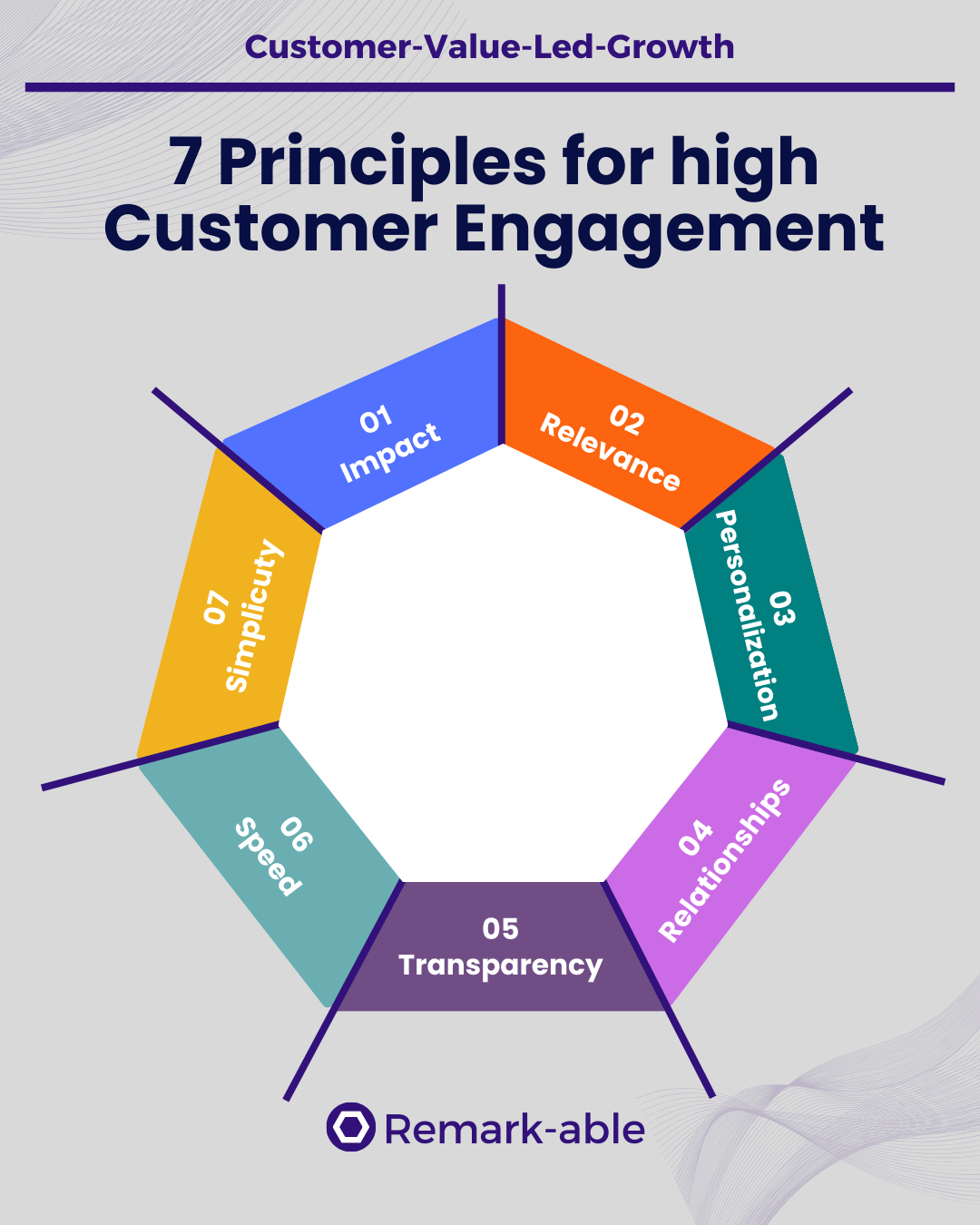
Hi, Markus here. Welcome to a premium edition of the Customer-Value-Led-Growth Newsletter.
Every week, I share strategies, guides, and frameworks to help you create exceptional value for your customers and company.
If you are not a paid subscriber, here’s what you might have missed:
Customers going dark? Tired of re-engaging them over and over again? You are not alone.
If you have searched for ideas on how to improve your customer engagement like me you probably came across tactical advice like
personalize outreach
create loyalty programs
build tailored journeys
which I don’t find helpful at all.
That’s why in today’s post, I want to share with you the 7 fundamental principles for high customer engagement I’ve identified:

1. Impact
Your customers have purchased your product because they want to achieve their goals. As long as they are making progress and seeing results they will be engaged.
If they are failing to do so, they will stop engaging until they eventually churn. This is the universal law and nothing else can be a substitute for it.
That’s why it is so important to stop with all the guessing and assuming and replace it with measuring and getting specific feedback.
Aim for making every E-mail, meeting, content and service helping customers to move one step closer to their desired outcomes. And going above & beyond once they’ve achied it.
The only way to accomplish this goal is to continously measure the success of your inputs. Defined as the % of customers moving forward after consumption.
Not to mix up with the consumption itself - open or attendance rates, number of views or downloads, etc. do not measure impact.
2. Relevance
“Show me that you know me” is not a catchphrase. Relevance is closed related to making an impact. Because if customers are not reading your mails, meeting with you, consuming content, etc. none of it will have any effect.
Customers don’t care for check-in E-mails for a “pulse check”
They don’t want to search through 30 articles to find the 1 piece that is actually helpful for their use case
They don’t want to participate in irrelevant courses and webinars
They don’t want to join QBRs that are all about what you care about
It’s not possible to get everything 100% right with every customer and that’s ok. But trial & error is not a viable concept either. Aim for “delivering value with every interaction” at 95% accuracy.
The key for relevance is to deeply understand your customers and their resulting needs.
3. Personalization
Unpopular opinion: There’s no such thing as personalization at scale. Why? Because they are diametral opposites.
All companies actually do is breaking up the one-size-fits all into a limited number of options based on product usage, health scores or consumption.
It’s one step forward but if you really want to personalize customer engagement you need to understand the context.
Because you can have 2 customers
Roughly the same size
Comparable revenue
From the same industry
Trying to accomplish the same goals
By solving the same goals
Starting from the same skill levels
plus similar usage patterns, health scores and consumption that still have different needs. Because they don’t have the same people and culture.
When it comes to personalization, context is king.
4. Relationships
There’s not a shortage of tips and ways to improve customer relationships. But what they are all missing is the most important thing: The beginning.
“There’s no second chance for a first impression” is not only true when it comes to customers trying your product for the first time.
It also applies when you start building relationships. How can you make the best possible start? Show your customers that you really care about their success.
The best way to do that is to meet with customers for a good old-fashioned 1:1 conversation.
Ask your customers open questions to learn more about their business and their needs but otherwise let them do the talking.
Aim for listening 80% of the time and only do 20% of the talking. Make your customers feel heard and understood and they will become emotionally invested.
If they feel like you are just checking off items from a list with zero enthusiasm you will achieve the exact opposite.
5. Transparency
Strong customer relationships are built right from the start. A key ingredient is to win your customers’ trust. The best way to build trust is with transparency.
Answer your customers’ questions even when it means to do something uncomfortable.
Customers need to hear the truth about
the outcomes that are possible (even when they were sold otherwise)
the time and effort they need to put in
painful roadblocks they might be facing
What if customers are leaving afterward? You have saved both time because it was not meant to be.
Being transparent also means to keep your customers updated without them asking for it. Walk them through the process, share the next steps and explain them to your customers.
6. Speed
Your customers don’t care about the number of open tasks on your to-do list. They don’t care about the number of E-mails in your inbox that require a response.
They want answers to their questions and responses to their requests asap. How can you ensure high responsiveness on your side? You need to prioritize ruthlessly.
Of course, you want to have all the customers in your portfolio highly engaged. But ask yourself whether that’s even possible.
Isn’t it better you have a highly engaged minority instead of a mediocre majority? Review your activities through the same lense.
Eliminate the could do’s and postpone the should do’s after the must-do’s.
7. Simplicity
Your customers want to achieve their desired outcomes. And they want to get there as fast as easy as possible.
Eliminate redundancies, potential misunderstandings, double work and most importantly cut the c***.
You are not creating guides for SEO purposes, you are creating them to educate your customers
You are not creating tutorials to present every feature, you are creating them to help customers solve problems within minutes.
Don’t write lengthy E-mails - none wants to read them.
Don’t invite customers to a meeting that could have been an E-mail
Simplicity is actually about doing “more with less”. Switch sides and view everything you do from the customers’ perspective.
If there are things you would hate to do, content you find difficult to consume, etc. there’s a high chance your customers feel the same.
Here’s how I can be of further help:
Customer Value-Led Growth Cohort Training: Learn how to deliver, grow, and monetize Customer Value to accelerate your career.
Product Store: Get Ebooks, Templates, and actionable Guides to expand your skills and knowledge.
Promote your product or service to 5k+ subscribers sponsoring my newsletter.
